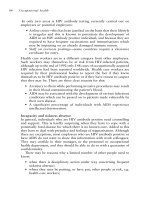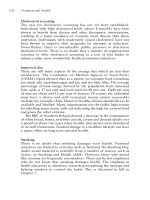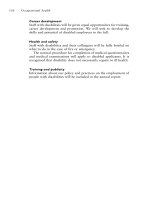Boards That Love Fundraising A How-to Guide for Your Board potx
Bạn đang xem bản rút gọn của tài liệu. Xem và tải ngay bản đầy đủ của tài liệu tại đây (2.5 MB, 130 trang )
Zim.ffirs 1/7/04 10:14 AM Page v
Boards That Love
Fundraising
A How-to Guide
for Your Board
Robert M. Zimmerman
and Ann W. Lehman
Zim.ffirs 1/7/04 10:14 AM Page i
Zim.ffirs 1/7/04 10:14 AM Page ii
Zim.ffirs 1/7/04 10:14 AM Page iii
Boards That Love Fundraising
Zim.ffirs 1/7/04 10:14 AM Page iv
Zim.ffirs 1/7/04 10:14 AM Page v
Boards That Love
Fundraising
A How-to Guide
for Your Board
Robert M. Zimmerman
and Ann W. Lehman
Zim.ffirs 1/7/04 10:14 AM Page vi
Copyright © 2004 by John Wiley & Sons, Inc. All rights reserved.
Published by Jossey-Bass
A Wiley Imprint
989 Market Street, San Francisco, CA 94103-1741 www.josseybass.com
The materials that appear in this book (except those for which reprint permission must be obtained from
the primary sources) may be reproduced for educational/training activities. We do, however, require that
the following statement appear on all reproductions:
Boards That Love Fundraising: A How-to Guide for Your Board by Robert M. Zimmerman and Ann W. Lehman
Copyright © 2004 by John Wiley & Sons, Inc.
This free permission is limited to the reproduction of material for educational/training events. Systematic
or large-scale reproduction or distribution (more than one hundred copies per year)—or inclusion of items
in publications for sale—may be done only with prior written permission. Also, reproduction on computer
disk or by any other electronic means requires prior written permission. Requests to the Publisher for
permission should be addressed to the Permissions Department, John Wiley & Sons, Inc., 111 River Street,
Hoboken, NJ 07030, (201) 748-6011, fax (201) 748-6008, e-mail:
Jossey-Bass books and products are available through most bookstores. To contact Jossey-Bass directly
call our Customer Care Department within the U.S. at 800-956-7739, outside the U.S. at 317-572-3986 or
fax 317-572-4002.
Jossey-Bass also publishes its books in a variety of electronic formats. Some content that appears in print
may not be available in electronic books.
Library of Congress Cataloging-in-Publication Data
Zimmerman, Robert M., 1947–
Boards that love fundraising : a how-to guide for your board / by
Robert M. Zimmerman and Ann W. Lehman.
p. cm.
Includes bibliographical references and index.
ISBN 0-7879-6812-9 (alk. paper)
1. Fund raising. 2. Nonprofit organizations—Finance. I. Lehman, Ann
W. II. Title.
HG177.Z547 2004
658.15'224—dc22
2003024913
Printed in the United States of America
first edition
PB Printing 10987654321
Zim.ftoc 1/7/04 10:15 AM Page vii
Contents
About the Authors xi
Introduction xv
1 What Every Board Member Needs to Know to Start Fundraising 1
The Five Responsibilities of a Nonprofit Board 1
Specific Board Fundraising Responsibilities 2
A Healthy Board 5
Advisory Boards 6
Campaigns 7
2 Fundraising Rules Underlying Successful Appeals 10
Programming Determines Funding 10
Getting People to Ask 12
People Love to Give Away Money 18
People Give Money to People 19
Fundraising from the Perspective of the Donor, Not the Applicant 21
People Give to Strength, Not Crisis 22
Specificity is Next to Godliness 24
Successful Fundraising Depends on Careful Record Keeping 27
Ten Percent of the People Give 90 Percent of the Money 29
Donors’ Gifts Must Be Recognized Immediately 30
Good Fundraising is Opportunistic 32
3 The Board’s Role in Specific Fundraising Activities 35
Individual Contributions 36
Contributions from Businesses 61
Grants 66
4 Effective Board Recruitment 70
Whom to Recruit 71
How to Recruit 72
vii
Zim.ftoc 1/7/04 10:15 AM Page viii
viii
Contents
5 Primed for Fundraising 78
Creating a Development Plan 78
What the Board Needs to Understand About Fundraising Staff 84
What Development Staff Can and Cannot Do 86
Specific Fundraising Roles 87
Fundraising Costs 89
Working with Consultants 91
Evaluating Your Fundraising Effort 92
Conclusion 95
Resource A: Major Donor Solicitation: Asking for the Gift 97
Resource B: Major Donor Solicitation Scripts 103
Index 109
Zim.ftoc 1/7/04 10:15 AM Page ix
Exercises
Exercise 1: Programming Determines Funding 13
Exercise 2A: Fundraising Fears 16
Exercise 2B: Responding to Solicitation 17
Exercise 3: What Moves People to Give 18
Exercise 4: The Personal Touch 20
Exercise 5: Organizational Sales Pitches 22
Exercise 6: Organizational Strengths and Weaknesses 24
Exercise 7: Making the Case for Funding 26
Exercise 8: Donor Record Keeping 28
Exercise 9: Who Are Your Major Donors? 30
Exercise 10: Donor Recognition 32
Exercise 11: Securing Press Coverage 33
Exercise 12: Why Would Someone Make a Gift
to Your Organization? 37
Exercise 13: Direct Mail—Personal Notes 40
Exercise 14: Evaluating and Planning Your Special Event 44
Exercise 15 Telephone Follow-up to a Direct Mail Appeal 46
Exercise 16 Major Gift Solicitation 51
Exercise 17A: If Your Organization Does Not Already Have a
Planned Giving Program 55
Exercise 17B: Strengthening Your Planned Giving Program 55
Exercise 18: On-line Fundraising 60
Exercise 19A: Corporate Sponsorship Request 65
Exercise 19B: Brainstorming Prospective Business Donors 66
Exercise 20A: Contacts at Prospective Foundation Grantors 68
Exercise 20B: Meeting with a Foundation Executive 68
ix
Zim.ftoc 1/7/04 10:15 AM Page x
Zim.flast 1/7/04 10:15 AM Page xi
About the Authors
ROBERT (BOB) ZIMMERMAN and ANN W. LEHMAN lived through and were
influenced heavily by the idealism of the 1960s. While less naïve now, they
have not lost their enthusiasm for creating a just and healthy world. Their
work today provides nonprofit organizations with pragmatic action plans
to guarantee operational effectiveness and financial success.
Bob Zimmerman, fundraising specialist and president of Zimmerman
Lehman, has more than thirty years of experience in the areas of fund
-
raising, board and volunteer training and development, and executive
search. A 1969 graduate of Antioch College, with a master’s degree in polit
-
ical science from the University of Michigan, he started his career at a large
community counseling program in Boston as a grantwriter (in the good old
Nixon days, when federal money was easily found). He has been the direc
-
tor of development at a variety of nonprofit organizations on both coasts,
including an independent living center for physically disabled people in
Los Angeles and a national public interest law office in San Francisco.
In 1988, he founded Zimmerman Lehman, a consulting firm whose
motto is “forging futures for nonprofits.” The firm specializes in fundraising,
organizational development, and executive search exclusively on behalf of
nonprofits. He has consulted with numerous organizations both large and
small in every area of nonprofit endeavor. He has taught thousands of indi
-
viduals the art and science of fundraising, in particular helping trainees
overcome their fears. He has conducted his renowned interactive workshops
throughout the United States and in Europe on such topics as Zimmerman’s
rules of fundraising, major donor solicitation, grantseeking, hiring top-notch
executive staff, and capital campaigns.
He has served on the board of directors of the Golden Gate Chapter of
the Association of Fundraising Professionals (AFP) and has cochaired AFP’s
xi
Zim.flast 1/7/04 10:15 AM Page xii
xii
About the Authors
“Fundraising Day” in San Francisco. He is the author of the newsletter
The Zimmerman Telegram and its more modern incarnation, ZimNotes, an
e-newsletter on fundraising started in 1997. He has also written the train
-
ing manuals Grantseeking: A Step-by-Step Approach; Major Donors: The Key to
Successful Fundraising; and Maximum Dollars: The 12 Rules of Fundraising; he
is the coauthor (with partner Ann W. Lehman) of The Effective Nonprofit
Board: Responsibilities and Recruitment.
Ann W. Lehman, lawyer, planning specialist, executive coach, trainer,
and policy expert, has worked in the public interest arena for more than
twenty-five years. She brings her wide experience as executive director,
activist, senior policy analyst, consultant, trainer, facilitator, board member,
and coach to the Zimmerman Lehman consultancy. She received her B.A.
from Rutgers University in New Jersey in 1974 and her J.D. from North
-
western School of Law in Portland, Oregon, in 1978. Immediately after law
school, she supervised a storefront public interest law center in Portland
geared to senior citizens. She has directed an alternative bar association in
New York City; worked as a senior policy analyst on women, girls, and
human rights; and was the executive director of a public interest law office
specializing in issues affecting seniors.
She joined Zimmerman Lehman in 1991 and has consulted and taught
workshops in such areas as strategic and programmatic planning, board
responsibilities and recruitment, fundraising, leadership, advocacy, office
management, human rights, work-life issues, and sexual harassment. She
has facilitated numerous conferences and retreats nationwide. She is
coauthor of Zimmerman Lehman ‘s book The Effective Nonprofit Board:
Responsibilities and Recruitment and webmistress of Zimmerman Lehman’s
website, www.zimmerman-lehman.com.
She has also developed a sexual harassment prevention program and
worked extensively implementing the Convention on the Elimination of All
Forms of Discrimination Against Women (CEDAW), a human rights treaty
for women and girls in San Francisco. She has authored a survey and report
on work-life options and a major report on girls in San Francisco. Ann also
chairs her neighborhood association and is a member of the El Cerrito Eco
-
nomic Development Board.
Bob Zimmerman and Ann Lehman, also life partners, live in El Cerrito,
California, with their son, Gabe Z. Lehman, and their dog, Stella.
Zim.flast 1/7/04 10:15 AM Page xiii
Acknowledgements
WITHOUT A DOUBT the real heroes of this book are the many individuals
who work at nonprofit organizations and dedicate their lives to ensuring
we live in a healthy and equitable world. In particular, we would like to
thank our client staff members who grapple daily to balance the variety of
needs of their organizations, board members who volunteer their time and
treasure, and donors who believe in the value of our clients’ work. While
we preach in this book that organizations need to be more “businesslike,”
we know that the “bottom line” is not a measure of success and that the
many individuals who work so hard are not doing so for the lucrative
salaries or benefits that nonprofits provide. We hope after reading this book
that that will change!
There are many challenges in writing a book. As both professional and
personal partners, we would like to acknowledge each other for having
completed this book with our relationship still intact, our different strengths
recognized and our sense of humor revitalized. This would not have been
possible without the assistance of Rinat Fried, who provided so much help
and good cheer as we prepared the first draft.
We would also like to thank our parents and families for their openness
about the issue of money and for their belief in us as successful human
beings.
xiii
Zim.flast 1/7/04 10:15 AM Page xiv
Zim.flast 1/7/04 10:15 AM Page xv
Introduction
WE CANNOT PRAISE TOO HIGHLY the contributions that nonprofit organi-
zations make to the welfare of communities throughout the United States.
The “third sector” (after for-profit companies and the government) creates
millions of jobs and offers services that benefit millions more; nonprofit
board members, staff, and other volunteers are to be congratulated for their
Herculean efforts. We are thankful also for this nation’s longstanding phil
-
anthropic tradition. Whether the economy is good or bad, whether the pre-
vailing political winds are liberal or conservative, Americans can be
depended upon to make handsome contributions to organizations amount
-
ing to hundreds of billions of dollars annually.
The money is out there, even in tough economic times. For example,
according to Giving USA, a publication of the American Association of
Fundraising Counsel’s Trust for Philanthropy, more than $241 billion was
given to 1.4 million charitable organizations in 2002. This represents 2.3 per
-
cent of the U.S. gross domestic product and constitutes an increase in
absolute dollars over 2001.
1
What is remarkable here is that 2002 was a very
poor year economically in the United States, yet people continued to give.
If so much money is potentially available, why are so many organiza-
tions suffering from too little revenue? The answer has nothing to do with
the fickleness of the public, “donor fatigue,” or the controversial nature of
certain nonprofit activities. The answer, quite simply, is that board and staff
members don’t ask for money effectively, they don’t ask often enough, and
sometimes they don’t ask—period. Every year, billions of dollars that could
be invested in the nonprofit sector are lost because organizations aren’t ask
-
ing properly.
Many board members, volunteers, and staff members view fundraising
as “genteel begging” rather than as creating opportunities for citizens to
xv
Zim.flast 1/7/04 10:15 AM Page xvi
xvi
Introduction
invest in successful enterprises through philanthropic contributions. This
book is grounded in the conviction that nonprofits are business enterprises
similar in many important respects to for-profit enterprises. As a member
of a nonprofit board, you should make sure that your organization is care
-
fully managed, is fulfilling its mission, and has sufficient financial resources
at its command to implement current and future programs.
You can also learn to be an effective “salesperson” for your organization.
Although you sell concepts (for example, a healthier environment, better-
educated children, or cultural enrichment), not products, you are a sales
-
person nonetheless. In soliciting new prospects, cultivating donors, and
diversifying your funding base, your fundraising job as a board member
is to satisfy the “customer” (that is, the donor) without misrepresenting
the work of your organization. Donors should be proud to invest in your
organization!
As nonprofit consultants with decades of experience working with all
types of organizations, from small start-ups to large nationwide enterprises,
we cringe when we hear the oft-repeated lament, “I was told when I joined
this board that the one thing I wouldn’t have to do was fundraising!” In
fact, the board of directors is the single most important element in nonprofit
fundraising. An enthusiastic, well-trained, and well-connected board guar
-
antees fundraising success. An indifferent or hostile board with no connec-
tions to money, no determination to forge those connections, and no interest
in learning fundraising techniques gravely compromise your organization’s
ability to achieve its goals. As a member of a nonprofit board, you can and
must help ensure your organization’s financial well-being.
This book is divided into five chapters. Chapter One, “What Every
Board Member Needs to Know to Start Fundraising,” explains your fund
-
raising responsibilities as a board member and presents information on
board structure and its impact on raising money. Chapter Two, “Fund
-
raising Rules Underlying Successful Appeals,” explains to you the concepts
that enable you to ask for money effectively and fearlessly. In Chapter
Three, “The Board’s Role in Specific Fundraising Activities,” we describe in
detail the variety of ways that nonprofits raise funds and the board’s role
in each area. Chapter Four, “Effective Board Recruitment,” steers you away
from “anecdotal” board recruitment and toward a rational recruitment pol
-
icy designed to draw folks to your board who will be of the greatest assis-
tance with fundraising and other board endeavors. Chapter Five, “Primed
for Fundraising,” deals with the critically important issues of fundraising
planning, staffing, evaluation, and working with consultants.
If you are new to the world of fundraising, we are confident that, hav-
ing completed this volume and done the exercises, you will understand
Zim.flast 1/7/04 10:15 AM Page xvii
Introduction
xvii
your fundraising role as a board member and be “rarin’ to go” to corral that
first gift. If you are a board member seasoned in particular aspects of fund
-
raising, we trust that this book will alert you to new areas in which you can
play a vitally important role and hone your fundraising skills.
A Word on the Exercises
The exercises in this book are designed to give you a hands-on appreciation
of fundraising concepts and techniques. Some exercises are role plays; oth
-
ers offer the opportunity for discussion about your organization’s devel-
opment efforts; still others provide the means to plan for a fiscally healthy
future.
Most of the exercises require a leader who acts as the facilitator. This
might be your board chair, your development committee chair, a staff mem
-
ber, or a consultant. In some exercises, we have listed questions for partici-
pants to consider. We encourage each person to write down his or her
answers prior to beginning the discussion; this will prove more fruitful than
simply jumping in.
Exercises are of course designed for your board of directors (or a sub-
group such as the development committee), but we hope that the executive
director and development director will also be included as appropriate.
Most of the exercises (other than the role plays) can also be completed by
individual board or staff members if it is inconvenient to assemble the full
board or development committee; simply brainstorm with yourself and
write down your responses to the questions. A few exercises involve con
-
sideration of confidential information; in these cases, we have given spe-
cific instructions concerning who should participate in the discussions.
Finally, we have included the amount of time that we anticipate each exer
-
cise will take. This varies with the number of people participating.
A word on terminology: since, in the nonprofit world, the terms fund-
raising and development are used interchangeably, we also use both words
to mean the same thing.
Note
1. Giving USA, a publication of the AAFRC Trust for Philanthropy, researched and
written by the Center on Philanthropy at Indiana University.
Zim.flast 1/7/04 10:15 AM Page xviii
Zim.c01 1/7/04 10:08 AM Page 1
Chapter 1
What Every Board
Member Needs to Know
to Start Fundraising
SINCE YOU ARE READING this book, we can assume at the very least that
you appreciate the importance of board members’ involvement in your
organization’s development efforts. Although not the board’s only respon
-
sibility, fundraising is often what causes the most trepidation on the part of
both new and seasoned members. A few of you may be wildly enthusiastic
about the prospect of talking to potential donors and convincing them to
invest in your organization; most of you probably find the prospect daunt
-
ing. To place fundraising in proper perspective, let’s take a look at your
overall responsibilities as a board member.
The Five Responsibilities of a Nonprofit Board
Nonprofit board members have five major responsibilities:
1. To ensure sound planning and policies (write the mission and vision
statements; make sure that programs accord with the mission)
2. To ensure good management (evaluate, hire, and if necessary fire the
executive director; review personnel policies)
3. To ensure sound resources and financial dealings (assist with fund-
raising and public relations; guarantee financial accountability)
4. To ensure compliance with legal requirements (file required papers and
act as a trustee/fiduciary; comply with bylaws)
5. To ensure good governance (conduct a periodic board self-evaluation;
keep minutes; recruit new members; update bylaws as appropriate)
Being an effective board member means more than just showing up at meet-
ings; it requires staying informed and asking difficult questions, participating
1
Zim.c01 1/7/04 10:08 AM Page 2
2
Boards That Love Fundraising
in planning and policy making, ensuring a sound financial footing, and mon-
itoring and evaluating the management and governance of the organization.
Specific Board Fundraising Responsibilities
A critically important part of good board management is ensuring the avail-
ability of adequate funds. What specifically should nonprofit board mem-
bers do in this regard? As a nonprofit board member, you have four
fundraising responsibilities:
1. To make a financial contribution to the extent of your capacity. Some
board members can make only a token gift annually; others can give $5
million. Each of you should make a “stretch” gift every year, regardless of
the specific amount. Other funders—particularly foundations and major
donors—will consider making contributions only if everyone on the board
has made a capacity gift. It is much easier to ask for money if you have put
your money where your mouth is!
2. To solicit contributions from your friends, relatives, and colleagues.
The most important reason that a person makes his or her first contribu
-
tion to a nonprofit organization is that the right person asks. You should
be prepared to approach the individuals on your Christmas, Chanukah,
Kwanzaa, Ramadan, or Solstice card list on behalf of your organization.
These approaches may be for a direct mail contribution, a seat at a special
event, a major gift, or a planned gift.
3. To assist with recruiting new members to your board of directors
who have the clout and connections to ensure the success of the fundraising
effort. To achieve critical mass when it comes to fundraising, your board
must contain at least a few people of means who have the ability to make
sizeable contributions and the desire to “put the arm” on friends and col
-
leagues. Peer-to-peer fundraising is the name of the game.
4. To oversee your organization’s fundraising efforts. As a board mem-
ber, it is not your responsibility to write grant proposals or enter donor
information in the database (unless there is no staff). You are responsible,
however, for making sure that your organization is pursuing funds by every
appropriate means. The board mandates preparation of a written fund
-
raising plan and reviews fundraising activities periodically to ensure timely
and comprehensive implementation of the plan.
As fundraising consultants, we have worked with thousands of board mem-
bers at hundreds of nonprofit organizations, and it is rare indeed for any-
one to say, “Naturally those are our responsibilities! Lead on!” We face
instead a variety of concerns about each responsibility.
Zim.c01 1/7/04 10:08 AM Page 3
3
What Every Board Member Needs to Know to Start Fundraising
Making a Financial Contribution
to the Extent of Your Capacity
First, with reference to making their own financial contributions, typical
objections and complaints voiced by board members include:
“I give my time, and that’s more valuable than money!”
“What difference can my small gift make to a huge nonprofit like this?”
“I serve on three nonprofit boards. How can I contribute to each one?”
We certainly appreciate the time that board members donate, but this
doesn’t replace money. If you are a consultant in the field of public health
who bills at $350 an hour and you spend five hours per month on nonprofit
board work, this does not equate to $1,750, because $1,750 does not appear
magically in the organization’s bank account. Of course volunteer hours
matter—but so does money.
If your organization has an annual budget of $10 million, why should
anyone care about your contribution of $250? Two reasons: first, the huge
majority of that $10 million may be restricted to particular projects, and your
$250 unrestricted contribution is therefore extremely helpful in meeting such
mundane expenses as utility bills and purchasing copy paper. Second, your
modest contribution is vitally important philanthropic advertising. Prospec
-
tive major individual donors are likely to ask solicitors from the board if they
have made contributions themselves. The right answer? “Yes, and my gift
was the largest I’ve ever made to a nonprofit organization,” or “Yes, and it
was a real stretch, but that’s how much this organization means to me.” Some
nonprofit board members serve on more than one board, and their largesse
is therefore spread thin. We appreciate this problem and ask only that board
members do the best they can to bolster each organization’s revenues.
Soliciting Contributions from Your
Friends, Relatives, and Colleagues
The very idea of asking friends for contributions fills many board members
with fear and loathing. When we conduct board fundraising trainings, we
always ask this question: “How many of you would rather ask a stranger
for a large gift than a friend?” Inevitably, the majority of the folks in the
room raise their hands. Our response? “Ladies and gentlemen, you’re going
to have to get over it.”
Why? Because the most important tactical issue in fundraising is access.
How do you gain access to folks with money and the desire to help a wor
-
thy organization? You clearly do not have access to strangers; sending a let-
ter to Mr. and Ms. Dinero on Plush Drive requesting a contribution is
Zim.c01 1/7/04 10:08 AM Page 4
4
Boards That Love Fundraising
pointless unless someone in your organization knows Mr. and Ms. Dinero
personally. We understand that not every board member has well-heeled
friends and colleagues, but everyone knows folks who could make modest
contributions. The folks whom you know will at the very least grant you an
audience or be willing to read a request letter to which you have appended
a personal note. As we discuss later in this book, you must learn to over
-
come the fears that keep you from asking your intimates for contributions.
Recruiting New Members with Clout and
Connections to Your Board of Directors
Board members at small- and medium-sized organizations are often reluc-
tant to invite folks with money and connections onto their board. This reluc-
tance is equal parts fear of being intimidated and what we term “reverse
chic.” Current board members worry that someone with money and clout
will so intimidate them that they will never say another word at a board
meeting. Conversely, they honestly believe that a person of means could not
possibly relate to the work of their organization!
For example, one client, a small modern dance company in a large city
on the West Coast, called us for a board consultation. The dance company
was five years old at the time of our meeting; its initial funding included
grants from foundations and government agencies, as well as modest con
-
tributions from local businesses. The board was made up of dancers, chore-
ographers, and friends of the artistic director. The grants and contributions
were drying up, and they needed advice on what to do next.
We suggested that they needed to raise funds from individuals; to do
so, it was vitally important to expand their board. “How about asking the
manager of the bank branch at which you do business to join your board?”
we suggested. Their reaction spoke volumes about intimidation and reverse
chic: “What?” said one of the current board members. “What could a bank
manager possibly know about modern dance?”
There are two issues here. First, the bank manager is not being asked to
choreograph a production; what matters is that he or she cares a great deal
about dance. More important, to dismiss the idea of a banker serving on the
dance company’s board is to deny the board a powerful fundraising ally.
Overseeing Your Organization’s Fundraising Efforts
Finally, board members are often uncomfortable in the role of overseer of the
development effort. They would rather cede this responsibility to staff.
“Thank heavens we’ve hired our first development director,” board members
often say. “No more fundraising for us!” In fact, a good development direc
-
Zim.c01 1/7/04 10:08 AM Page 5
5
What Every Board Member Needs to Know to Start Fundraising
tor makes your board work hard and consistently at fundraising. In addition,
the development director and executive director look to the board for guid
-
ance in planning and implementing all facets of your fundraising effort.
As discussed in Chapter Five, the board should commission a written
fundraising plan, to be prepared either by the development director or a
consultant. The plan gives your organization its fundraising marching
orders for three years. As a board member, it is your responsibility to review
the plan periodically and interview staff to determine whether all necessary
steps have been taken to implement it.
A Healthy Board
Healthy organizations raise more money than their ailing counterparts. At
Zimmerman Lehman, we believe board health depends upon an effective
chairperson, functioning committees, and stable operations. The chair
-
person is an informed and enthusiastic leader. He or she chairs board meet-
ings, meets regularly with the executive director to review operations, and
stays in touch with committee chairs to make sure that committees are oper
-
ating smoothly (more on this later). The board chair is also responsible for
soliciting financial contributions from all board members.
An effective nonprofit board relies on standing committees to do the
lion’s share of the work. Every member of your board should be responsible
for serving on at least one committee:
• Executive: sets the board agenda and makes emergency decisions between
board meetings on behalf of the entire board
• Finance: oversees fiscal operations
• Nominating: reviews current board composition, makes recommenda-
tions concerning the background of new members, and interviews pro-
spective members
• Personnel: prepares personnel policies and evaluates the executive director
• Program: monitors program operations and makes recommendations to
the executive director
• Public relations: gives the organization a higher profile in the community
by speaking at appropriate public gatherings and serving as contact
people with print and electronic media
• Membership: those organizations whose members directly elect the board
of directors—a small but hardy minority—should also have a board
membership committee to determine such things as categories of mem
-
bership and requisite dues









